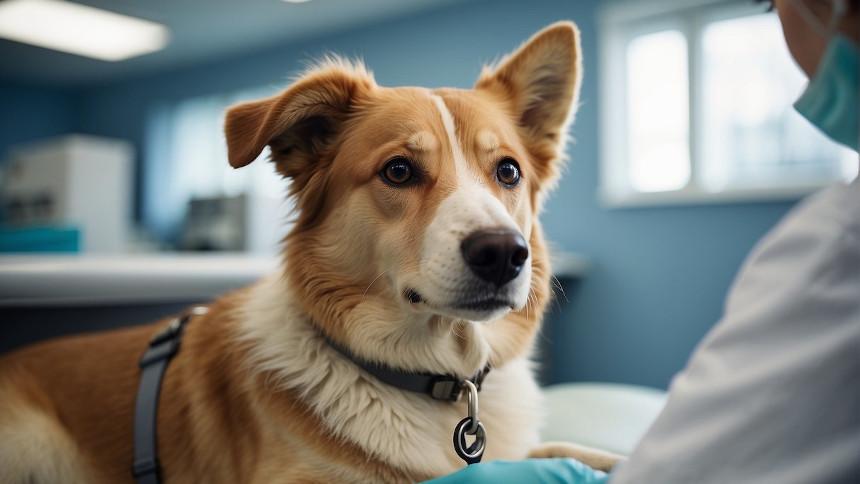When a dog vomits white foam, it can be a concerning and confusing symptom for pet owners. This type of vomiting can point to a variety of underlying issues, ranging from relatively minor to more serious conditions. The foam itself is typically a mixture of air, saliva, and stomach fluids that appear frothy or bubbly. Observing other symptoms that accompany the vomiting, such as lethargy, diarrhea, or loss of appetite, can help in identifying the cause.
Various factors can contribute to a dog throwing up white foam. Common causes include gastric irritation due to eating something inappropriate, digestive issues like bilious vomiting syndrome, or more concerning health problems such as kidney or liver disease. In some instances, an immediate veterinary consultation is necessary, especially if the vomiting is accompanied by signs of distress or persists over time.
Determining the exact reason why a dog is vomiting white foam requires a careful evaluation of the animal’s behavior, diet, and overall health. Effective treatment hinges on the accurate diagnosis of the underlying condition – whether that involves dietary changes, medication, or more extensive medical intervention. It’s essential for dog owners to monitor their pets and seek veterinary advice to ensure appropriate care and prevent future episodes.
Recognizing the Symptoms
When a dog is vomiting white foam, it indicates that their stomach is empty and the substance is often a mix of saliva and gastric juices. Recognizing when a dog is in distress is crucial to provide timely care and intervention.
Physical Signs of Distress
- White Foam: The presence of white, foamy vomit is a prominent sign that the dog may be experiencing discomfort or an underlying health issue.
- Retching: Dogs may exhibit retching motions as they attempt to vomit, which can signal distress.
- Diarrhea: Concurrent symptoms such as diarrhea can indicate gastrointestinal upset or illness.
- Dehydration: Signs of dehydration, including dry gums and reduced skin elasticity, often accompany vomiting.
- Weakness or Lethargy: A sudden onset of weakness or reluctance to move can be associated with vomiting episodes.
- Pain: Observe any reactions that suggest abdominal discomfort or pain, such as whimpering or resistance to being touched around the stomach area.
Behavioral Indicators
- Loss of Appetite: Dogs will often lose interest in food, which can exacerbate weakness and lethargy.
- Behavioral Changes: A dog in distress may exhibit changes in behavior, becoming more withdrawn or unusually clingy.
- Coughing: In some cases, vomiting white foam may be preceded or accompanied by bouts of coughing.
- Fever: If the vomiting is caused by an infection, the dog might display symptoms of fever, including increased body temperature and listlessness.
Monitoring a dog for these symptoms provides essential clues to their well-being and whether veterinary attention is needed. It is important to consider the whole picture of the dog’s health to understand the severity of their condition.
Possible Causes and Related Health Issues
When a dog throws up white foam, it is often a sign of an underlying health issue that may range from mild dietary indiscretions to serious infections or gastrointestinal problems. Understanding the possible causes is critical for seeking appropriate veterinary care.
Dietary Issues and Ingestion
Dietary indiscretion, including the ingestion of unsuitable foods like grass or high-fat content meals, can lead to vomiting white foam due to indigestion or even more severe concerns like pancreatitis. If a dog eats something irritating or inedible, such as a foreign object, this can also cause gastric upset and gastrointestinal obstruction, leading to similar symptoms.
- Common dietary issues:
- Overeating or eating too quickly
- Consumption of products not designed for dogs (e.g., bread)
- Food allergies
Infections and Diseases
Dogs may vomit white foam due to infectious diseases that range from localized bacterial infections to systemic viral illnesses. Contagious diseases, such as canine parvovirus, can cause severe symptoms, including vomiting. Additionally, health issues like inflammatory bowel disease may contribute to the presence of foamy vomit.
- Examples of infections and diseases:
- Canine distemper
- Parvovirus
- Bacterial infections such as leptospirosis
Gastrointestinal and Internal Problems
Bloat or gastric dilatation-volvulus is a critical condition that may manifest with vomiting white foam and requires immediate medical action. Acid reflux, sometimes due to stress or toxin exposure, can also lead to vomiting foam, as can more chronic conditions like kidney disease. Bile may be present if the vomiting occurs with an empty stomach. Internal obstructions, due to a foreign body, not only trigger vomiting but can also cause life-threatening emergencies.
- Key gastrointestinal concerns:
- Bloat
- Gastrointestinal obstruction
- Acid reflux
- Kidney disease
Diagnosis and Veterinary Intervention
When a dog exhibits symptoms such as vomiting white foam, it necessitates a thorough examination and possibly advanced diagnostic tests to ascertain the underlying cause. Veterinarians generally begin with an initial assessment and may proceed to more sophisticated techniques if routine tests prove inconclusive.
Initial Assessment and Tests
Veterinarians start by collecting a detailed medical history to check for any previous health issues or current medications that might explain the vomiting. This is often followed by a comprehensive physical exam, which can reveal signs of distension, abdominal pain, or dehydration that might accompany vomiting.
The most common diagnostic tests include:
- Blood work: to evaluate organ function, white and red blood cell counts, and to detect any signs of infection or inflammation.
- X-rays: to check for obstructions, foreign bodies, or abnormalities within the abdomen that may cause vomiting.
- Ultrasound: to gain a more detailed view of the abdominal organs and detect any underlying conditions that might not be evident on x-rays.
Advanced Diagnoses Techniques
If initial tests are inconclusive, veterinarians may resort to advanced diagnostics such as:
- Endoscopy: This procedure entails using a flexible tube with a camera to visualize the esophagus, stomach, and beginning of the small intestine. It can identify foreign objects, tumors, and areas of inflammation that could cause vomiting.
Key Considerations:
- A thorough approach to diagnosis can prevent escalation into a medical emergency.
- If a bacterial infection is suspected, samples taken during endoscopy can be crucial for identification.
- It is essential to determine whether the cause of vomiting is life-threatening or if it stems from less severe underlying medical conditions.
Across these diagnostic steps, veterinarians focus on identifying the cause with precision, ensuring that the treatment provided is both effective and tailored to the dog’s specific needs.
Treatment Options and Home Care
When a dog repeatedly throws up white foam, it is crucial to address dehydration and underlying health issues. Medical treatments and home care, including dietary management, are key to helping a dog recover.
Medical Treatments
Veterinary care is essential for dogs who persistently vomit white foam. A veterinarian may administer anti-nausea medications and antibiotics if an infection is suspected. Hospitalization and intravenous fluids may be necessary for severe cases to combat dehydration and provide supportive care.
- Anti-Nausea Medications: To reduce vomiting and discomfort.
- Antibiotics: Target potential infections that might cause vomiting.
- Intravenous Fluids: Counteract dehydration and maintain electrolyte balance.
- Hospitalization: For constant monitoring and medical support if the dog’s condition is critical.
Dietary Management and Home Remedies
For mild cases of upset stomach leading to white foam vomit, pet parents may implement home care remedies:
- Bland Diet: Consists of boiled chicken and rice to soothe the digestive tract.
- Water: Ensure the dog has access to fresh water to prevent dehydration.
Here are specifics to manage the dog’s diet:
- Gradual Feeding: Initially withhold food for a few hours, then slowly reintroduce a bland diet.
- Small Portions: Give small amounts of a bland diet spread throughout the day.
It is important to consult with a veterinarian before making changes to the dog’s diet or starting any home treatments.
Prevention and Long-Term Health
Preventing a dog from vomiting white foam involves managing diet and health checks to address issues like dietary indiscretion and infections. This approach maintains their overall well-being and mitigates potential health concerns.
Diet and Nutrition
A balanced diet is crucial for preventing dietary issues that can lead to vomiting. Dog owners should ensure that their pets have a diet formulated for their specific life stage, size, and any medical needs. Puppies, due to their growth requirements, and older dogs, with possibly slower metabolisms, need differently composed diets. Regular dietary indiscreetness, such as consuming table scraps or non-food items, like toys or grass, should be avoided.
- Key Components of Diet:
- High-quality commercial food or a vet-approved homemade diet
- Adequate hydration
- Limited human food and treats to prevent toxin exposure and maintain balanced nutrition
- Consultation with a veterinarian for a specialized diet if the dog is prone to health issues like inflammatory bowel disease
Routine Health Checks
Health checks are essential for early detection and prevention of diseases that can cause vomiting, such as bacterial infections or kennel cough. Vaccinations play a significant role in disease prevention. Core vaccinations, including those for rabies, are critical for long-term health and legal requirements in many areas.
- Health Check Focus:
- Vaccines: Keeping up to date with vaccinations to prevent common illnesses
- Regular Check-ups: Bi-annual or annual veterinary visits depending on the dog’s age and health status
- Observation: Monitoring for signs of distress or abnormal behavior, indicating the need for veterinary care
Dog owners are advised to maintain consistent veterinary care, which includes advisement on a bland diet when necessary, and professional removal of any ingested foreign object to ensure their pet’s health and prevent incidents of vomiting foam.








